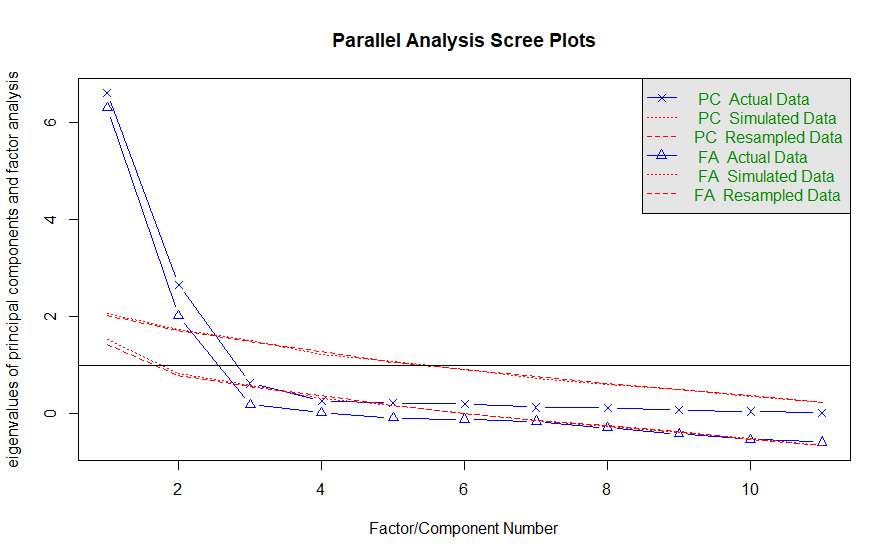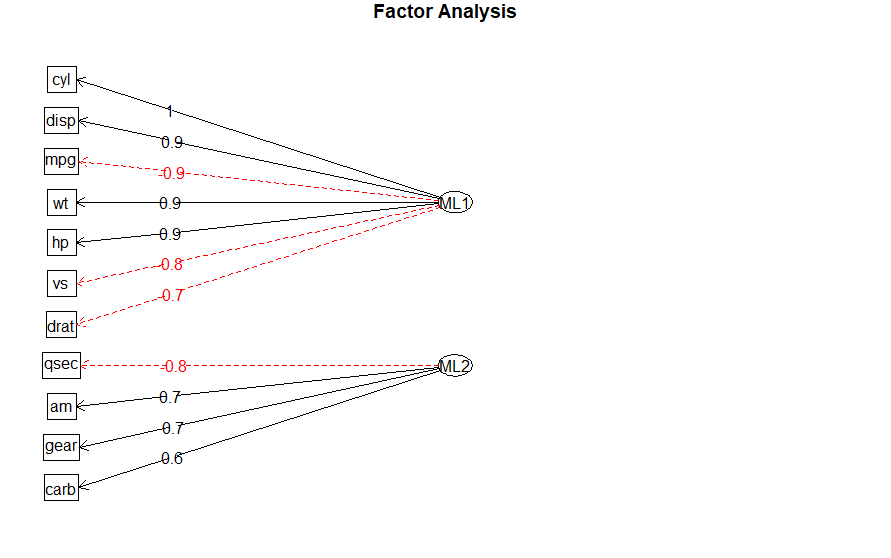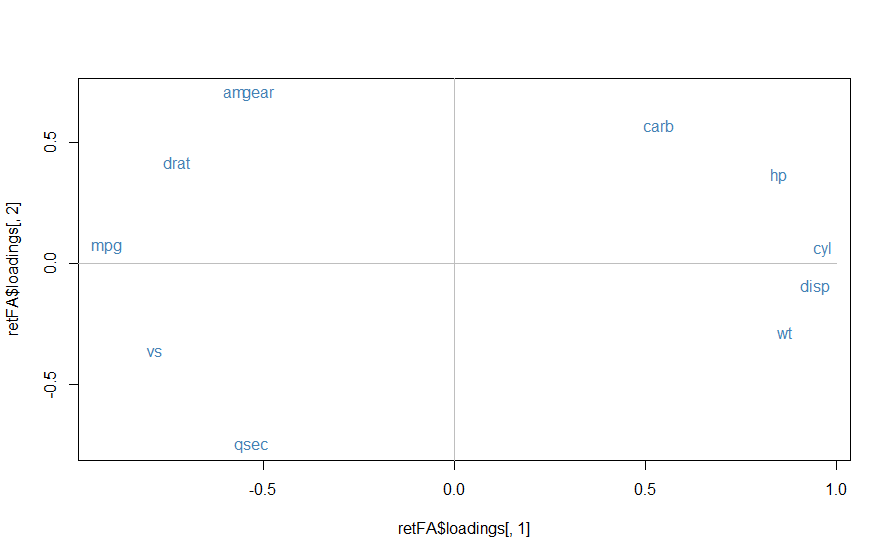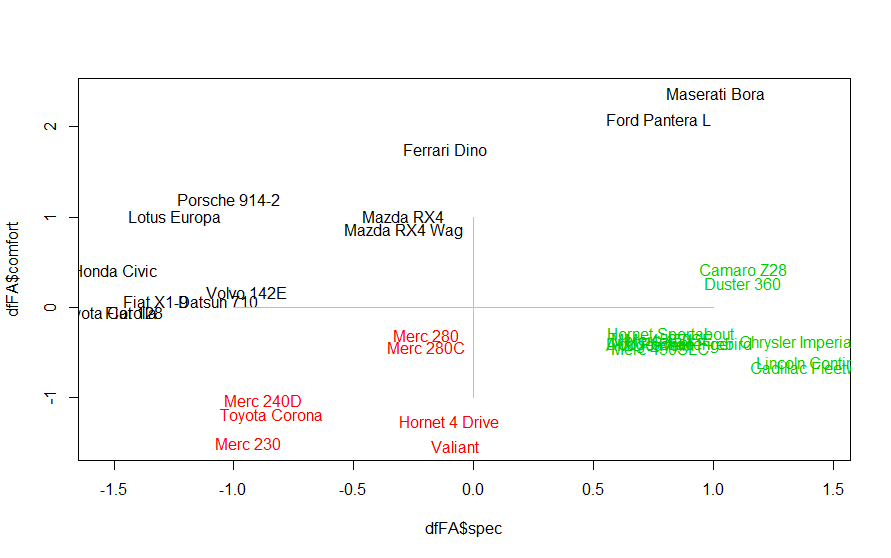【R】因子分析とクラスタリング
2020年5月15日
1.はじめに
こちらでは、mtcarsのデータを用いて因子分析をしました。今回は、この後にクラスタリングまで行ってみたいと思います。
2.因子分析
2.1 因子数を決める
psychパッケージの並行分析の関数fa.parallelを用いてスクリープロットをひょじします。この結果、1以上である因子数を2とします。
library(psych) #スクリープロットで因子数を決める。 result.prl<-fa.parallel(mtcars, fm="ml")

2.2 因子分析
因子分析をし、結果を表示します。
#因子分析 retFA<-fa(mtcars, nfactors=2, fm="ml", rotate="carimax", sores="regression") #結果を表示 print(retFA, digits=2, sort=TRUE)
Factor Analysis using method = ml
Call: fa(r = mtcars, nfactors = 2, rotate = "carimax", fm = "ml",
sores = "regression")
Standardized loadings (pattern matrix) based upon correlation matrix
item ML1 ML2 h2 u2 com
cyl 2 0.96 0.06 0.93 0.070 1.0
disp 3 0.95 -0.09 0.90 0.096 1.0
mpg 1 -0.91 0.07 0.83 0.167 1.0
wt 6 0.87 -0.28 0.83 0.168 1.2
hp 4 0.85 0.36 0.86 0.143 1.4
vs 8 -0.78 -0.36 0.74 0.256 1.4
drat 5 -0.73 0.42 0.70 0.298 1.6
qsec 7 -0.53 -0.75 0.85 0.150 1.8
am 9 -0.58 0.70 0.83 0.171 1.9
gear 10 -0.51 0.70 0.75 0.246 1.8
carb 11 0.54 0.57 0.61 0.386 2.0
ML1 ML2
SS loadings 6.44 2.41
Proportion Var 0.59 0.22
Cumulative Var 0.59 0.80
Proportion Explained 0.73 0.27
Cumulative Proportion 0.73 1.00
Mean item complexity = 1.5
Test of the hypothesis that 2 factors are sufficient.
The degrees of freedom for the null model are 55 and the objective function was 15.4 with Chi Square of 408.01
The degrees of freedom for the model are 34 and the objective function was 2.72
The root mean square of the residuals (RMSR) is 0.05
The df corrected root mean square of the residuals is 0.06
The harmonic number of observations is 32 with the empirical chi square 7.66 with prob < 1
The total number of observations was 32 with Likelihood Chi Square = 68.57 with prob < 4e-04
Tucker Lewis Index of factoring reliability = 0.832
RMSEA index = 0.175 and the 90 % confidence intervals are 0.118 0.243
BIC = -49.27
Fit based upon off diagonal values = 0.99
Measures of factor score adequacy
ML1 ML2
Correlation of (regression) scores with factors 0.99 0.96
Multiple R square of scores with factors 0.98 0.92
Minimum correlation of possible factor scores 0.96 0.85因子ML1>ML2の組(cyl, disp, mpg, wt, hp, vs, drat)とML1<ML2の組(qsec, am ,gear, carb)に分けられそうです。
2.3 ダイアグラム
因子分析の結果をダイアグラムで表示してみます。
#ダイアグラムで表示 fa.diagram(retFA)

2.4 散布図
因子1と因子2の関係を散布図で表してみます。
#因子1と因子2の関係をプロットしてみる plot(retFA$loadings[,1], retFA$loadings[,2], type="n") text(retFA$loadings[,1], retFA$loadings[,2], rownames(retFA$loadings), col="steelblue") lines(c(-1,1), c(0,0), col="grey") lines(c(0,0), c(-1,1), col="grey")

因子の解釈が難しいですが、仮に因子1をスペック(spec)に関するもの、因子2を快適さ(comfort)に関するものとします。
3.クラスタリング
クラスタリングの手法はいろいろありますが、ここではk-平均法(kmeans())を使います。実行結果は、実行のたびに異なるらしいです。
#k-平均法でクラスタリング
dfFA<-as.data.frame(retFA$scores)
rownames(dfFA)<-rownames(mtcars)
colnames(dfFA)<-c("spec", "comfort")
#クラスタリングを可視化
kmFA<-kmeans(dfFA, 3, iter.max=50)
color.kmFA<-kmFA$cluster
color.kmFA<-as.character(color.kmFA)
levels(color.kmFA)<-c("blue", "red", "green")
head(color.kmFA)
color.kmFA<-as.character(color.kmFA)
plot(dfFA$spec, dfFA$comfort, type="n")
text(dfFA$spec, dfFA$comfort, rownames(dfFA), col=color.kmFA)
lines(c(-1,1), c(0,0), col="grey")
lines(c(0,0), c(-1,1), col="grey")

どう解釈してよいかわかりませんが、練習ということで。。。
